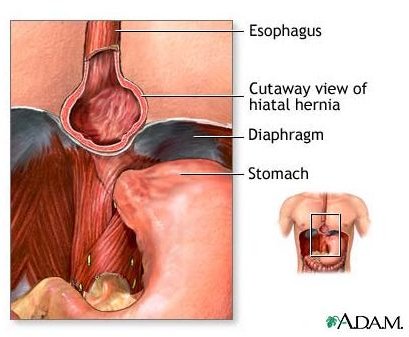What Is a Hiatal Hernia?
What is a Hiatal Hernia?
A hiatal hernia, or hiatus hernia, is a condition when part of your stomach bulges upward into your chest, through your diaphragm. The diaphragm refers to the muscular wall that separates the chest cavity from the abdomen. The diaphragm has a hiatus (small opening) in which the stomach pushes up through this opening, leading to a hiatal hernia. Click on image to enlarge.
A small hiatal hernia does not normally result in health problems, but a large one may enable stomach acid and food to regurgitate into the esophagus. This condition eventually causes acid reflux or gastroesophageal reflux disease (GERD) and heartburn, making symptoms worse.
You might suffer from both hiatal hernia and GERD at times, but they do not necessarily mean having causal effect. Nevertheless, you might have a hiatal hernia without symptoms of GERD.
Two types of hiatal hernia include:
- Sliding hiatal hernia is a condition when a small portion of the stomach pushes through the hiatus and into the chest.
- Paraesophageal hernia is a condition when the stomach and esophagus keep remaining where they are, but a small portion of the stomach presses through the hiatus, making it possible to stay beside the esophagus.
Causes and Risk Factors
Possible causes of hiatal hernia might include:
- Congenital defect due to a large hiatus
- Weakness of the supporting tissue
- Constant pressure on the adjacent muscles due to vomiting, coughing, or pushing too hard during childbirth
- An injury to the diaphragm
Some risk factors of this condition include:
- Increasing age above 50 years old
- Smoking
- Obesity
Signs and Symptoms
If you have a small hiatal hernia, you may not have any symptoms. However, you may experience burning sensation (heartburn) in the chest, nausea, sour taste in the back of the throat, and belching once you have a large hiatal hernia. You might mistake chest pain, caused by hiatal hernia, for a heart attack. Therefore, it is recommended having your doctor examine your condition.
Diagnosis
There are two examinations to diagnose this condition including:
Esophagogastroduodenoscopy (EGD)
The doctor may suggest you take this test to examine the lining of the esophagus, stomach, and upper duodenum with a small and flexible endoscope. Once you have taken a sedative, your doctor inserts this medical device into your throat to check for irritation. This examination might last about 20 minutes or less.
Barium X-ray
You need to swallow barium, a liquid contrast material, to enable your upper digestive tract to be discernible in an x-ray. The examination performs a clear image of your esophagus, stomach, and the upper part of the duodenum.
Treatment
Symptoms, such as heartburn or acid reflux (GERD), can be allayed by taking baking soda (sodium bicarbonate) as natural treatment, or several recommended medications, such as proton pump inhibitors (PPIs), H2 blockers, and antacids.
Treatment for this condition may include a surgical procedure, where a surgeon inserts a tiny camera and several surgical devices through your abdomen before withdrawing the stomach into the abdomen thereby keeping the hiatus smaller.
References
MayoClinic.com: Hiatal Hernia - https://www.mayoclinic.com/health/hiatal-hernia/DS00099
Myclevelandclinic.org: What is a Hiatal Hernia? - https://my.clevelandclinic.org/disorders/hiatal_hernia/ts_overview.aspx
MedlinePlus: Hiatal Hernia - https://www.nlm.nih.gov/medlineplus/ency/article/001137.htm
Photo Credit
Image courtesy of the National Library of Medicine.
